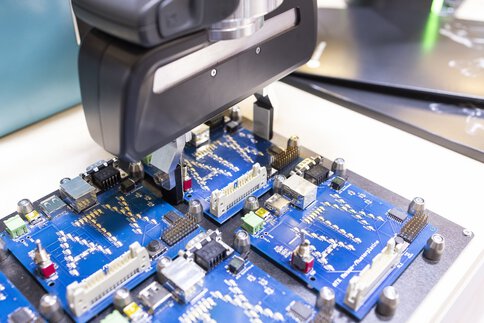Ceramics in electronics—key material for high-performance systems
Technical ceramics are an indispensable material in electronics and electrical engineering. They serve as a high-temperature and high voltage-resistant insulator in switches, connectors and power electronics.
Ceramic substrates based on aluminum oxide or aluminum nitride form the backbone of modern electronic assemblies—they enable high packing densities, excellent thermal conductivity and reliable signal routing.
A wide range of ceramic components such as wafer carriers, nozzles, heaters or process chamber components are used in semiconductor manufacturing. Their chemical resistance, purity and dimensional stability make them ideal for use in demanding production environments.
The latest developments show how ceramics are overcoming the limits of conventional materials and enabling new applications in microelectronics, power electronics and sensor technology.
Ceramics in electronics and electrical engineering: key material for high-performance applications
Ceramic materials have become an integral part of modern electronics and electrical engineering. Whether as insulators in high-voltage systems, carriers in power electronics, or process components in semiconductor manufacturing, technical ceramics make an essential contribution to the miniaturization, increased efficiency and reliability of today’s systems. Their exceptional material properties such as high temperature resistance, electrical insulation, thermal conductivity and chemical stability make them ideal for a wide range of applications in a rapidly developing technological field.
A key field of application for ceramic materials is electrical insulation. Aluminum oxide (Al₂O₃), aluminum nitride (AlN) or steatite, electroporcelain and other materials have been used successfully for decades in insulators, bushings, high-voltage components and sensor housings. They benefit not only from their dielectric strength but also from their stability at extreme temperatures and in aggressive environments. In modern energy networks, railroad technology or industrial electronics, they ensure the operation and service life of key components.
Ceramic substrates for power electronics are increasingly coming into the spotlight: AlN and Si₃N₄ (silicon nitride) not only enable excellent heat dissipation from highly stressed semiconductor components but also mechanically robust and durable integration into modules and circuit boards. These materials are becoming ever more important, particularly in electric mobility, wind power and industrial drives, due to the growing demands regarding power density, temperature resistance and cycle stability. AMB (Active Metal Brazing) and DCB (Direct Copper Bonded) substrates on a ceramic basis also enable the construction of reliable and thermally resilient circuits.
Another growing area is ceramic components and process components for semiconductor manufacturing. Ceramic materials such as Al₂O₃, quartz glass, boron nitride or silicon nitride are used in vacuum technology, plasma etching and ion implantation. These materials need to be not only extremely pure but also chemically inert, temperature-resistant and low in particles, properties that are essential in manufacturing highly integrated chips. Additive manufacturing processes are also being tested more and more in order to further optimize geometries and functional integration.
Promising developments can also be found at the interface between ceramics and electronics: Multilayer ceramic components such as capacitors, inductors and filter elements have long been the standard in high-frequency technology and sensor technology. Thin-film ceramics on glass or flexible substrates open up new possibilities for printed electronics and contribute to the further development of compact, intelligent components. Piezoceramic actuators and ultrasonic sensors, for example, in medical technology or the automotive industry, are also based on innovative ceramic materials.
With the ongoing expansion of renewable energies, progress in semiconductor technology and the increasing electrification of many areas of life, ceramic components are becoming more important. Their role as functional, high-performance and adaptable materials will become even more central to technological innovations in the future.

ceramitec @ productronica 2025
productronica, which will take place from November 18 to 21, 2025, is the world's leading trade fair for the development and manufacture of electronics. ceramitec will be represented there with its own booth, as technical ceramics are an indispensable material in electronics and electrical engineering.
At the ceramitec booth at productronica 2025, we will be demonstrating how the high-performance material ceramics enable innovations in electrical engineering. Discover how synergies between materials and electronics expertise can be leveraged to drive forward future fields such as e-mobility, medical technology, sensor technology, and energy efficiency.
Visit us in Hall B2, Booth 177!
ceramitec 2026 – Ceramics as a key material for tomorrow's electronics
- Experience material innovation live – from ceramic substrates to functional materials for electronics manufacturing.
- Discover synergies between materials and electronics expertise.
- Exchange ideas with leading experts from research and industry.
- Get inspiration for more efficient, sustainable, and powerful electronic solutions.
Your direct way to ceramitec 2026!
All it takes is a few clicks to go online and purchase your personal ticket to ceramitec or directly redeem your voucher.
